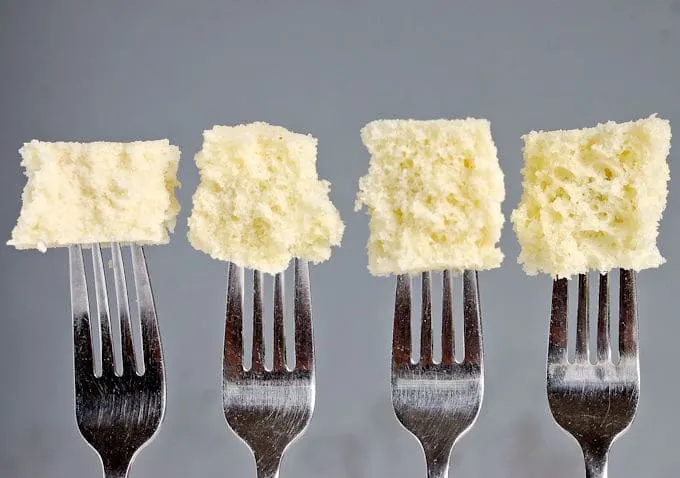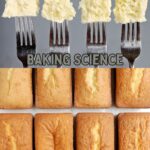🧂 Baking Powder & Baking Soda in Baking
If you love baking from scratch, understanding how chemical leavening works is one of the most powerful tools in your kitchen.
Baking soda and baking powder may look similar, but they behave very differently once they hit liquid or heat. Knowing which to use, and how much, helps ensure your cakes rise evenly, your cookies spread properly, and your muffins have the right crumb.

Table of contents
What are Baking Powder & Baking Soda?
When an acid and an alkali meet in the presence of moisture, they release carbon dioxide gas. If you ever made a “baking soda volcano” as a school science project you’ve seen this reaction.
In baking, that gas becomes trapped inside batter or dough, expanding during baking and creating lift.
The Science of Baking Soda
Baking soda (sodium bicarbonate) is a base that requires acid to create gas. Acidic ingredients like buttermilk, yogurt, brown sugar, molasses, or citrus juice trigger the reaction.
Without enough acid, baking soda decomposes into carbon dioxide and sodium carbonate, an alkaline compound with a soapy, bitter flavor.
Excess alkaline will also cause chocolate to look red (the origin of devil’s food cake) and blueberries to turn green.
👉 When a recipe contains natural cocoa, buttermilk, or fruit purée, baking soda is the right leavener.
The Science of Baking Powder
If a recipe doesn’t contain an acidic ingredient, baking powder steps in. Baking powder already includes both an acid (often cream of tartar or monocalcium phosphate) and a base (baking soda), along with a bit of cornstarch to keep it dry.
Most baking powders are double-acting, meaning:
- The first release of gas occurs when liquid is added.
- The second, stronger reaction occurs when the batter hits the heat of the oven.
This two-step process gives batters enough structure before the final expansion — which is why double-acting powder is ideal for consistent rise.
Salt also plays a quiet but important role here — it strengthens gluten and subtly moderates chemical reactions during baking. Learn more in Salt in Baking.
How much leavener do I need?
A general guide:
- ¼ teaspoon baking soda or 1 teaspoon baking powder per 1 cup of flour.
- ½ teaspoon baking soda neutralizes about 1 cup of acidic ingredient.
Just a little baking math – Recipes often employ a combination of baking powder and baking soda, using just enough baking soda to neutralize the acid in the recipe, but also enough total leavener to lift the flour in the recipe.
For example, if a pound cake contains 2 cups of flour and ½ cup of yogurt:
- ¼ tsp baking soda neutralizes the yogurt.
- 1 tsp baking powder lifts the rest of the flour.
Of course, how the dough or batter holds those gas bubbles depends on the flour’s protein content — see Flour in Baking to understand how gluten provides structure for those air pockets.
Baking Sense Tip
With a properly leavened recipe, the batter surrounding the air bubbles will have time to set in the oven before the final burst of carbon dioxide expands.
Too much leavener, however, can backfire: the batter rises too fast, then collapses before it sets.
How to make your own baking powder
Mix:
- 1 part baking soda
- 2 parts cream of tartar
- 1½ parts cornstarch
Because this mixture uses a single, fast-reacting acid, batters should go straight into the oven after mixing.
Pastry Chef tips for using baking powder and baking soda
- Check expiration dates — old baking powder or soda loses potency.
- Use baking powder even in acidic batters (like buttermilk cakes) when you want a slightly acidic flavor and a tender texture.
- Store baking soda tightly sealed; it readily absorbs moisture and odors.
This is why baking is both an art and a science. It’s helpful to know about the science of the ingredients, but it takes a bit of an art to use them to get a recipe just as you like it.
📘 Continue Learning
This page is part of my Baking Ingredient Science series, where I explain how each ingredient affects texture, flavor, and structure in baking.
Explore more ingredient guides:
- Flour in Baking – structure and gluten formation
- Sugar in Baking – sweetness, tenderness, and moisture
- Fats in Baking – richness and flakiness
- Eggs in Baking – structure and emulsification
- Salt in Baking – balance and control
- Yeast in Baking – fermentation and flavor
- Chocolate in Baking – flavor and structure

